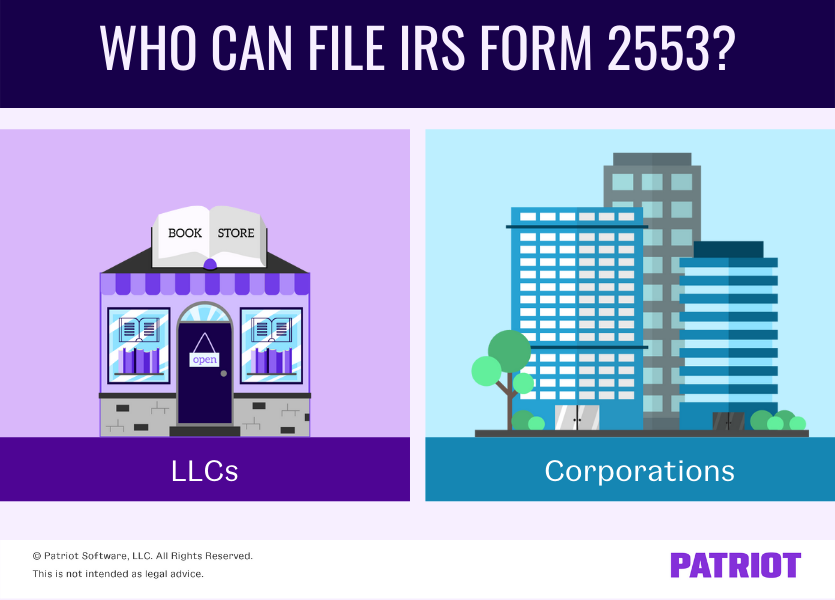When you start your business venture, you choose what type of business structure you want your company to be. Maybe you chose to be a sole proprietor and handle business on your own. Or, maybe you decided to structure your business as a corporation.
But, what happens if you’re not too keen on the structure you selected? Well, if you went the C Corp, single-member LLC, or multi-member LLC route, you can change the way your business is taxed using IRS Form 2553. So, what is Form 2553?
What is IRS Form 2553?
Form 2553 is the S Corp election form businesses need to use if they want to become an S Corp. Some businesses can save money on taxes by taking advantage of the S corporation election. Businesses taxed as S Corps don’t have to worry about double taxation.
After electing to be an S Corp, a company is taxed as a pass-through entity. With pass-through taxes, the tax passes through the business. Instead of the company directly paying the tax, another entity (e.g., business owner) pays the taxes. Income is only taxed once with pass-through taxation.
Tax Form 2553 Q&A session
So you’re interested in learning more about Form 2553, eh? Well, you’ve come to the right place. Take a look at the answers to some of the most-asked Form 2553 questions below.
Who can file IRS Form 2553?
Corporations (C Corps) and LLCs can use Form 2553 to elect S Corp tax status.
You can file IRS Form 2553 if you meet these requirements:
- The business is a domestic corporation
- The business has less than 100 shareholders and only one class of stock
- Shareholders are individuals, estates, trusts, and exempt organizations
- Shareholders are U.S. citizens, permanent residents, or resident aliens
- The business isn’t a bank, an insurance company, or a thrift savings institution
- The business uses a calendar tax year ending December 31, or another eligible fiscal year
- Each shareholder consents to S Corp status
If your business meets the requirements, you can become an S Corp for federal tax purposes by filling out Form 2553.

When is Form 2553 due?
Filing Form 2553 on time is important if you want to take advantage of S Corp treatment for the tax year.
You must file Form 2553 no later than two months and 15 days after the beginning of the tax year when you want the S Corp election to take effect. Established businesses can also file Form 2553 any time during the preceding tax year.
Take a look at a breakdown of when each business needs to file Form 2553:
- Established businesses: Due by March 15 of the new tax year (e.g., 2020) or anytime during the preceding tax year (e.g., 2019)
- New businesses: Due by March 15
How do you fill out Form 2553?
If you plan on filing Form 2553, you need to know what information to include on your form.
Part I of the form covers Election Information. This includes the following information:
- Name
- Address
- Employer Identification Number (EIN)
- Date incorporated
- State of incorporation
- Election date (e.g., date you want S Corp to start)
- Tax year
- Contact information for a legal representative
- Explanation for late filing, if applicable
In the first section, you must also include shareholder information, including each shareholder’s name, address, signature, stock owned, Social Security number, and when their tax year ends.
Part II goes over the Selection of Fiscal Year. You only need to fill out Part II if you checked box 2 or box 4 on line F in Part I.
If you need to fill out Part II, mark off which statement applies to your business on line O (e.g., a new corporation adopting the tax year).
You must then indicate the type of tax year test you’re using on line P. You can select either the natural business year or the ownership tax year.
Line Q asks you for information about your business purpose. After you fill out line Q, you can move on to line R. Line R discusses information about Section 444 Election. Check off the box under line R that applies to you.
Part III goes over information about Qualified Subchapter S Trust (QSST). A QSST is a trust that owns shares of an S Corp. Most small businesses do not need to fill out this portion of the form. If this section applies to you, be sure to fill it out.
Lastly, Part IV discusses Late Corporate Classification Election. If you’re filing before the deadline, you can ignore Part IV.
If you’re submitting the form late, you must agree to the representations listed under Part IV. Representations are the eligibility requirements you need to meet in order to have late election relief.
If you’re unsure about a section or question on the form, check with the IRS for more Form 2553 instructions.
Where do you send Form 2553?
You can either mail or fax Form 2553 to the IRS. You cannot e-File Form 2553.
If you choose to send Form 2553 via mail, make sure it’s the original form and not a copy. If you opt to fax the form to the IRS, keep the original form in your records for safekeeping.
There’s generally no fee to submit Form 2553. But in specific situations, the IRS might assess a fee. If the IRS tacks on a fee, you’ll receive a separate bill from the IRS with instructions on how to pay it.
After you submit Form 2553, you’ll typically hear back from the IRS within 60 days. The IRS will let you know whether they accept or reject your S Corp tax status request.
What happens if you file Form 2553 late?
If you miss the filing deadline for Form 2553, don’t panic just yet. You can still obtain S Corp status for the upcoming tax year if you have proof of “reasonable cause” for filing late.
If you’re looking for late filing relief, list your explanation on line I of Form 2553 or by attaching a statement to the form.
Before you file a late Form 2553, make sure you check with the IRS to ensure you qualify for late election relief.
Regardless of which business structure you select, you need an easy and reliable way to track your business’s income and expenses. With Patriot’s accounting software, you can streamline your accounting process and get back to your business in no time. Give it a go with a free trial today!
Have questions, comments, or concerns about this article? Like us on Facebook, and let’s get talking!
This is not intended as legal advice; for more information, please click here.



